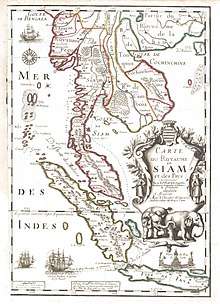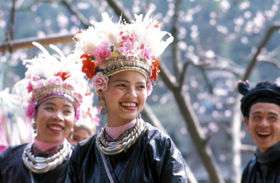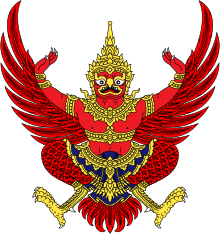Peopling of Thailand
The peopling of Thailand refers to the process by which the ethnic groups that comprise the population of present-day Thailand came to inhabit the region.
Part of a series on the |
|---|
| History of Thailand |
 |
|
Legendary Suvarnabhumi Central Thailand Dvaravati Lavo Supannabhum Northern Thailand Singhanavati Ngoenyang Hariphunchai Lanna Southern Thailand Pan Pan Raktamaritika Langkasuka Srivijaya Tambralinga Nakhon Si Thammarat Sultanate of Pattani Kedah Sultanate Malacca Sultanate Satun Reman |
| History |
|
Regional history |
|
Related topics
|
|
|
Gradual inland migration of Tai peoples from China
The Tai migration from the northern mountains into Thailand and Laos was a slow process, with the Tai generally remaining near the mountainous area in the region, where they were able to use their specialized agricultural knowledge relating to the use of mountain water for rice production. The earliest Tai settlements in Thailand were in the river valleys in the northern reaches of the country.
Eventually, the Tai settled the central plains of Thailand (which were covered with dense rainforest) and displaced and inter-bred with the pre-existing Austroasiatic population. The languages and culture of the Tai eventually came to dominate the regions of both modern-day Laos and Thailand. In more recent times, many of the Tai tribes of Laos also migrated west across the border, establishing communities in Thailand. The Laotian Tai ethnic groups, often referred to as the Lao, are largely clustered in the Isan region of Thailand.
Origin of the Tai peoples

Comparative linguistic research seems to indicate that the Tai people were a proto-Tai–Kadai-speaking culture of southern China, and like the Malayo-Polynesians, they may originally have been of Austronesian descent.[1] Prior to living in mainland China, the Tai are thought to have migrated from a homeland on the island of Taiwan, where they spoke a dialect of proto-Austronesian or one of its descendant languages.[1]
Unlike the Malayo-Polynesian group who later sailed south to the Philippines and other parts of maritime Southeast Asia, the ancestors of the modern Tai-Kadai people sailed west to mainland China and possibly traveled along the Pearl River, where their language greatly changed from other Austronesian languages under the influence of Sino-Tibetan and Hmong–Mien language infusion. The coming of the Han Chinese to this part of southern China may have prompted the Tai to migrate once again. This time they went over the mountains of southern China into Southeast Asia through the mountains of Burma and Laos to the north of present day Thailand.[2]
The Tai ethnic groups are believed to have begun migrating south from China to Southeast Asia during the first millennium CE. While this theory of the origin of the Tai currently predominates, there is insufficient archaeological evidence to prove it, and linguistic evidence alone is not conclusive. In support of the theory, however, it is believed the O1 Y-DNA haplogroup is associated with both the Austronesian people and the Tai.
Tai ethnic fusion
Over the centuries, the Tai intermarried and absorbed many of the other populations who co-inhabited and/or politically occupied the region, particularly populations of Mon–Khmer, Burmese, and Chinese descent. This fusion of ethnicity has led to considerable genetic diversity in the modern Thai people, and has resulted in a Tai population that differs in culture, language, and apparel from the Tai ethnic groups who remained in China. Many of the individual Tai ethnic groups have assumed a common Thai identity and have adopted Thai cultural norms.
Individual Tai ethnic groups in Thailand
There are presently more than 30 distinct Tai ethnic groups in Thailand, contributing nearly 85 percent of the nation's population. The genetic stratification of the ethnic clades of the Tai ethnicity is an ongoing topic of debate among linguists and other social scientists.
Continuous diverse Chinese immigration from the 13th century
The history of Chinese immigration to Thailand dates back many centuries, and the specific Chinese ethnic groups which made their way to Thailand are numerous, although there is a greater concentration of Chinese from the southern provinces due to their geographic proximity to Thailand. The Chinese are part of the greater Sino-Tibetan ethnicity which also includes the Tibeto-Burmans. The Chinese immigrants were largely able to merge into the predominant Tai culture, and have contributed significantly to the economy and infrastructure of Thailand over the years.
Chinese immigration during the Ayutthayan Period
Chinese traders in Thailand, mostly from Fujian and Guangdong Provinces, began arriving in Ayutthaya by at least the 13th century. Ayutthaya was under almost constant Burmese threat from the 16th century, and the Qianlong Emperor of the Qing Empire was alarmed by Burmese military might. From 1766-1769, the Qianlong Emperor sent his armies four times to subdue the Burmese, but all four invasions failed. Ayutthaya fell to the Burmese in 1767. During the Ayutthaya period, many Chinese traders and soldiers inter-married with local Tai, infusing Chinese culture into the population early in its history.
18th and 19th century male Chinese immigration
In the late-18th century, King Taksin of Thonburi, who was himself half-Chinese, actively encouraged Chinese immigration and trade. Settlers came from Chaozhou prefecture in large numbers.[3] By 1825, the population of Chinese in Thailand had reached 230,000, and it grew steadily due to a constant stream of Chinese immigrants to the country throughout the 19th century. Early Chinese immigration consisted almost entirely of Chinese men, who, of necessity, married Thai women. The children of such intermarriages were called luk-jin (ลูกจีน), meaning 'children of Chinese' in Thai.[4]
20th century immigration of Chinese families
The Chinese population in Thailand had risen to 792,000 by 1910. By 1932, approximately 12.2 percent of the population was ethnic Chinese. The corruption of the Qing dynasty and the massive population increase in China, combined with high taxes, caused many families to leave for Thailand in search of work and a better life. Those who came before the First World War came overland or by sailboats called sampams, while after World War II most arrived by steam ship.[5] The earlier tradition of Chinese-Thai intermarriage declined once large numbers of Chinese women immigrated in the early-20th century. New arrivals frequently came as families and resisted assimilation, retaining their Chinese culture and living in all-Chinese areas.
Lolo migration from Tibet via Burma

Some Loloish tribes such as the Lisu arrived in Thailand as recently as 100 years ago,[6] while others came at a much earlier date. The Lolo are believed to have descended from the ancient Qiang people of western China, who are also said to be the ancestors of the Tibetan, Naxi, and Qiang peoples. They migrated from southeastern Tibet through Sichuan and into Yunnan Province, where their largest populations can be found today.
Origin of the Lolo
The Lolo (also commonly referred to as the Yi) are one of the two major distinct Tibeto-Burmese ethnicities within present-day Thailand, along with the Karen. The Lolo migrated southeast from Burma into Thailand.
Individual Loloish ethnic groups in Thailand
The Loloish of Thailand are generally hill tribes in the northern portion of the country, near the border with Burma. A list of the Loloish ethnic groups of significant size within Thailand are as follows:[7]
- Southern Loloish clade
- Akha sub-clade
- Akha (population of approximately 60,000 in Thailand, centered on Chiang Rai, Chiang Mai, and Mae Hong Son Provinces)
- Lahu (population of approximately 52,000 in Thailand)
- Bisu (population of approximately 1,000 in Thailand, centered on Chiang Rai and Lampang Provinces)
- Mpi (population of approximately 1,200 within Thailand)
- Phunoi
- Ugong
- Akha sub-clade
- Northern Loloish clade
- Lisu (population of approximately 16,000 in Thailand)
Hmong–Mien migration from China via Laos

Like the Lolo, many of the Hmong–Mien ethnic groups are among the hill tribes in Thailand. Their population is clustered in the northeastern region of Thailand near the Laotian border. The Hmong–Mien of Thailand generally migrated from China in the second half of the 19th century through Laos, where they established themselves for some time prior to their arrival in Thailand.[8] An exception to the China-Laos-Thailand migration pattern is the Iu Mien people, who apparently passed through Vietnam during the 13th century, prior to entering Thailand through Laos.[8] The Iu Mien arrived in Thailand approximately 200 years ago, contemporaneously with a large number of other Hmong–Mien migrants.[8]
Origin of the Hmong–Mien peoples
The primary homeland of the Hmong–Mien ethnicity is said to be Kweichow, a province of southern China, where they settled at least 2,000 years ago.[8]
Karen arrival as refugees from Burma
The Karen left Tibet and migrated to Burma as refugees, establishing themselves along the Burmese border with Thailand. When during World War II the Japanese occupied Burma, long-term tensions between the Karen and Burmese turned into open fighting. After the war ended, Burma was granted independence in January 1948, and the Karen, led by the KNU, attempted to co-exist peacefully with the Burman ethnic majority. However, in the fall of 1948, the Burmese government, led by U Nu, began raising and arming irregular political militias known as Sitwundan. In January 1949, some of these militias went on a rampage through Karen communities.[9] In 2004, the BBC cited aid agencies estimates that up to 200,000 Karen were driven from their homes during decades of war, with 120,000 more refugees from Burma, mostly Karen, living in refugee camps on the Thai side of the Burmese-Thai border.
Origin of the Karen
The Karen people's ancestors were from Tibet, and are Tibeto-Burman, and therefore distantly related to the Lolo.
Individual Karen ethnic groups in Thailand
There are approximately 510,000 people of Karen descent living in Thailand.[7] A list of the Karen ethnic groups of significant size within Thailand are:[7]
- Pa'o
- Pwo clade
- Phrae Pwo
- Northern and Western Pwo
- Sgaw–Bghai clade
- S'gaw
- Kayah (population of approximately 100,000 in Thailand, centered on Mae Hong Son Province)
See also
References
- Sagart, L. 2004. "The higher phylogeny of Austronesian and the position of Tai–Kadai". Oceanic Linguistics 43.411-440.
- Blench, Roger (2004). "Stratification in the peopling of China: how far does the linguistic evidence match genetics and archaeology?" (PDF). (Conference Paper for Symposium): Human Migrations in Continental East Asia and Taiwan: Genetic, Linguistic and Archaeological Evidence. Retrieved 30 October 2018.
- Bertil Lintner (2003). Blood Brothers: The Criminal Underworld of Asia. Macmillan Publishers. p. 234. ISBN 978-1-4039-6154-9.
- Rosalind C. Morris (2000). In the Place of Origins: Modernity and Its Mediums in Northern Thailand. Duke University Press. p. 334. ISBN 978-0-8223-2517-8.
- ARAdmin. "Chinese Migration to Thailand". Retrieved 13 May 2015.
- "BRIEFLY ABOUT THE LISU HILL-TRIBE IN THAILAND". Archived from the original on 2007-03-02. Retrieved 2007-11-01.
- "Thailand". Ethnologue. Retrieved 13 May 2015.
- Besaggio, Davide; et al. (2007). "Genetic variation in Northern Thailand Hill Tribes: origins and relationships with social structure and linguistic differences". BMC Evol. Biol. 7: S12. doi:10.1186/1471-2148-7-S2-S12. PMC 1963483. PMID 17767728.
- Martin Smith (1991). Burma - Insurgency and the Politics of Ethnicity. London and New Jersey: Zed Books. pp. 62–63, 72–73, 78–79, 82–84, 114–118, 86, 119.
